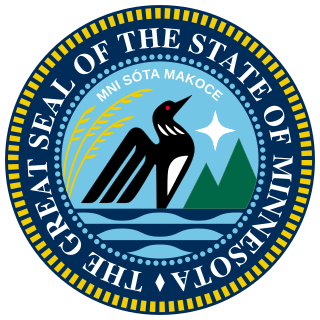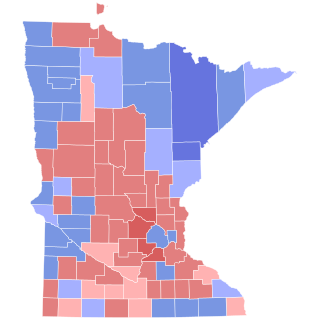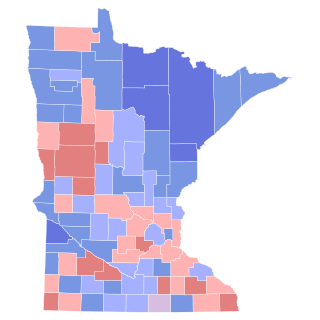
The 1984 United States presidential election was the 50th quadrennial presidential election, held on Tuesday, November 6, 1984. Incumbent Republican President Ronald Reagan and his running mate, incumbent Vice President George H.W. Bush, were re-elected to a second term in a landslide. They defeated the Democratic ticket of former Vice President Walter Mondale and Geraldine Ferraro.

Collin Clark Peterson is an American accountant, politician, and lobbyist who served as the U.S. representative for Minnesota's 7th congressional district from 1991 to 2021. A member of the Minnesota Democratic–Farmer–Labor Party (DFL). he was chairman of the House Committee on Agriculture from 2019 to 2021 and previously holding the office from 2007 to 2011; he had been ranking member from 2011 to 2019 and 2005 to 2007. Peterson was the most senior U.S. Representative from Minnesota and the dean of Minnesota's congressional delegation. In 2020, Peterson was defeated by Michelle Fischbach, ending his 30-year tenure in the United States House of Representatives. In 2022, Peterson registered as a federal lobbyist after opening an eponymous consulting firm.

The 1978 United States Senate elections were held on November 7, in the middle of Democratic President Jimmy Carter's term. The 33 seats of Class 2 were contested in regular elections. Special elections were also held to fill vacancies.

The 1972 United States Senate elections were held on November 7, with the 33 seats of Class 2 contested in regular elections. They coincided with the landslide re-election of Republican President Richard Nixon. Despite Nixon's landslide victory, Democrats increased their majority by two seats. The Democrats picked up open seats in Kentucky and South Dakota, and defeated four incumbent senators: Gordon Allott of Colorado, J. Caleb Boggs of Delaware, Jack Miller of Iowa, and Margaret Chase Smith of Maine. The Republicans picked up open seats in New Mexico, North Carolina, and Oklahoma, and defeated one incumbent, William B. Spong Jr. of Virginia.

The 1964 United States Senate elections were held on November 3. The 33 seats of Class 1 were contested in regular elections. Special elections were also held to fill vacancies. They coincided with the election of President Lyndon B. Johnson by an overwhelming majority, to a full term. His Democratic Party picked up a net two seats from the Republicans. As of 2023, this was the last time either party has had a two-thirds majority in the Senate, which allowed the Senate Democrats to override a veto, propose constitutional amendments, or convict and expel certain officials without any votes from Senate Republicans. However, internal divisions would have prevented the Democrats from having done so. The Senate election cycle coincided with Democratic gains in the House in the same year.

Cornelia Genevive Gjesdal "Coya" Knutson was an American politician from the U.S. state of Minnesota. She served two terms in the Minnesota House of Representatives, from 1951 to 1955, before winning election to the U.S. House of Representatives from Minnesota's 9th congressional district as a member of the Democratic–Farmer–Labor Party (DFL). She served two terms there, in the 84th and 85th Congresses,.

Arlan Inghart Stangeland was an American politician from Minnesota. As a Republican, Stangeland served in the United States House of Representatives from February 22, 1977 to January 3, 1991. He lost his campaign for reelection in the 1990 House election and subsequently retired from politics.

Odin Elsford Stanley Langen was an American politician from the state of Minnesota. He served six terms in the United States House of Representatives from 1959 to 1971.

Louis Wangberg is an American educator who was the 41st lieutenant governor of Minnesota. He was elected on the Independent-Republican ticket with Governor Al Quie and served from January 1, 1979, to January 3, 1983. He also served as Quie's chief of staff for part of the term until he sought the governor's office on his own. In 1982, when Quie chose not to run for reelection, Wangberg was the Independent-Republican endorsed candidate for governor, but lost the primary to Wheelock Whitney.

Minnesota is known for a politically active citizenry, with populism being a longstanding force among the state's political parties. Minnesota has consistently high voter turnout; in the 2008 U.S. presidential election, 77.8% of eligible Minnesotans voted – the highest percentage of any U.S. state or territory – versus the national average of 61.7%. This was due in part to its same day voter registration laws; previously unregistered voters can register on election day, at their polls, with evidence of residency.

The 2002 United States Senate election in Minnesota took place on November 5, 2002. Incumbent Senator Paul Wellstone was running for a third term but died in a plane crash eleven days before the election. The Democratic–Farmer–Labor Party (DFL) quickly chose former Vice President and 1984 presidential nominee Walter Mondale to replace Wellstone on the ballot. Mondale had previously held the seat from 1964 to 1976, resigning to assume the vice presidency. He narrowly lost to Republican Norm Coleman, the former mayor of Saint Paul. The day before the election, Governor Jesse Ventura appointed the 1996 Independence Party candidate, Dean Barkley, to serve the remainder of Wellstone's term.

Electoral history of Walter Mondale, who served as the 42nd vice president of the United States (1977–1981); as a United States senator from Minnesota (1964–1976), and as the 23rd attorney general of Minnesota (1960–1964).

The 1976 United States presidential election in Minnesota took place on November 2, 1976 as part of the 1976 United States presidential election. Voters chose ten electors, or representatives to the Electoral College, who voted for president and vice president.

The 2004 congressional elections in Minnesota were held on November 2, 2004, to determine who would represent the state of Minnesota in the United States House of Representatives.

The 1956 United States presidential election in Minnesota took place on November 6, 1956, as part of the 1956 United States presidential election. Voters chose 11 electors, or representatives to the Electoral College, who voted for president and vice president.

The 2018 United States House of Representatives elections in Minnesota were held on November 6, 2018, to elect the eight U.S. representatives from the state of Minnesota, one from each of the state's eight congressional districts. The elections coincided with an open gubernatorial election, a U.S. Senate election, a special U.S. Senate election, State House elections, and other elections.

The 1966 United States Senate election in Minnesota took place on November 8, 1966. Incumbent Democratic U.S. Senator Walter Mondale, who had originally been appointed in 1964 to replace Hubert Humphrey after Humphrey was elected Vice President of the United States, defeated Republican challenger Robert A. Forsythe, to win a full term.

The 1978 United States Senate special election in Minnesota was held on November 7, 1978. Democratic candidate Bob Short was defeated by Republican candidate David Durenberger.

The 2018 United States Senate special election in Minnesota took place on November 6, 2018, to elect a United States senator from Minnesota to replace incumbent Democratic senator Al Franken until the regular expiration of the term on January 3, 2021. Facing multiple accusations of sexual misconduct, Franken announced on December 7, 2017, that he would resign effective January 2, 2018. Governor Mark Dayton appointed Franken's successor, Tina Smith, on December 13, 2017, and she ran in the special election. This election coincided with a regularly scheduled U.S. Senate election for the Class 1 Senate seat, U.S. House elections, a gubernatorial election, State House elections, and other elections.

The 1998 Minnesota Attorney General election was held on Tuesday, November 3, 1998 to elect the Minnesota Attorney General for a four-year term. Incumbent DFL Attorney General Skip Humphrey ran for governor, and DFLer Mike Hatch won the election to replace him. The election marked the eighth attorney general race in a row won by the DFL since 1970.






















